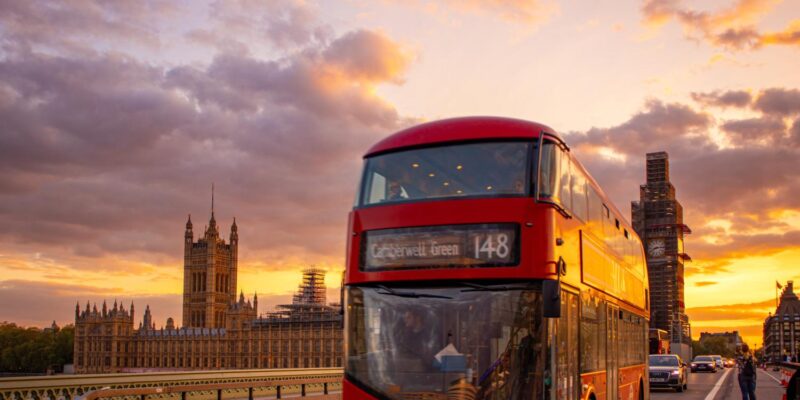Cities in crisis? How the UK Bus Services Act can improve health and the economy
Over 40,000 deaths a year in the UK are attributable to poor air quality, with air pollution being directly linked to cancer, asthma, strokes, heart disease, diabetes, obesity and dementia.1 The cost to the economy is estimated at £20bn per annum.2 In addition to this economic cost, there are air-quality requirements set out in legislation.3 In July 2017, the government published its air-quality plan to meet these legal requirements and address the cost of poor air quality.4
This health crisis has been exacerbated by rapidly increasing levels of car ownership and use, encouraged by low fuel prices and greater financial incentives to own cars through cheap, innovative leasing arrangements. Every large town and city in the UK is now blighted by growing levels of slow-moving traffic which, in addition to worsening air quality, are costing the economy another £30bn per annum.5
Collectively, we are wasting an estimated £50bn every year in making our largest towns and cities unpleasant and unsafe places to live. In addition, transport is one of the largest sources of carbon emissions contributing directly to climate change.6
Urban mobility
Mobility is a key requirement in our growing towns and cities but, currently, that requirement is largely being met in the least efficient and most unhealthy manner possible through a focus on a growing number of private cars shoehorned into limited road space and moving at ever slower speeds.
Air quality and congestion, and their impact on health and the economy, will only get worse unless there is a clear change in direction.
The only way to shift more people with fewer vehicle movements is to dramatically increase the level of ride-sharing on major corridors, particularly at peak travel times into and out of urban centres. That implies substantial modal shift towards public transport. This finding is at the centre of urban planning in many major European cities, including Paris, Brussels, Berlin and Rome.
Bold policies followed by successive Mayors of London over the last 15 years have driven modal shift from car to bus and the London Underground, with both modes showing significant growth over the last 15 years—use of the Underground grew by 42%, and bus use grew by 71% between 2000/01 and 2015/16.7 We have seen demand for rail travel grow exponentially in recent years as people look to find a faster, more convenient way to access urban centres—particularly London, but also other large cities.
There is, therefore, considerable potential to resolve the air-quality and traffic issues in the UK’s major towns and cities through modal shift from car to public transport. Different modes of transport have different benefits: rail can offer very high capacity, but at the cost of being expensive to deliver, with long lead times, and taking up significant amounts of scarce urban land unless it goes underground (which makes it much more expensive); buses are relatively cheap and very flexible, running on existing road networks, but offer lower capacity than rail; light rail and trams lie in between buses and rail in terms of capacity, cost and flexibility.
Given the flexibility and relatively low cost of buses compared with other modes of transport, they are an important part of the way to deliver the mobility that large urban areas need, as a key component of the overall package of public transport.
However, bus services are too often inhibited from being punctual and reliable by acute levels of traffic congestion that wreck reliability, lengthen journey times, and depress demand.
Research by Professor David Begg for the Greener Journeys campaign estimates that demand for urban bus services is falling at 10–14% per decade as a direct result of traffic congestion.8 He argues that the cost of delivering good-quality bus services is increasing by 8% per decade due to the effects of congestion, and that the problem is now also beginning to turn the growth in bus use in London into a decline.9
Research by Transport Focus has clearly identified that people will travel by bus in urban areas if the service is punctual, reliable and good value for money.10 The key question is therefore ‘how can these aspects be best delivered to produce the mode-switching that is so important in addressing air quality and congestion?’
The bus solution
The Bus Services Act 2017 received Royal Assent in late April and is the most fundamental change to UK bus legislation since the 1985 Transport Act. The Transport Act set up the current bus regulation regime, and the Bus Services Act opens up new opportunities for local authorities outside London to work with bus operators to improve the bus operating environment and deliver real growth through modal shift. This, in turn, should lead to improved air quality, and reduced congestion and carbon emissions.
The Bus Services Act was initially seen as the vehicle to give Greater Manchester similar powers to London to franchise its bus network as part of the Greater Manchester Devolution Deal. It was subsequently broadened to give new tools to all English local transport authorities outside London to work in partnership with operators.
The current decline in passenger volumes in London suggests that the historical growth in bus use there was driven not by its franchised regulatory environment, but by demographic and economic factors that were unique to London, as well as strong pro-bus policies by successive Mayors.11 This is reflected in experience outside the UK, where strong governance and leadership, combined with investment, is shown to deliver increases in the number of people using buses, regardless of the regulatory model.
Franchising a major urban bus network does not, of itself, change the fundamental dynamics and economics of delivering bus services. This explains the much higher levels of public subsidy required to sustain the London network which is, also, now turning from growth to decline.
The Franchising Powers contained in the Bus Services Act would also require significantly higher levels of public expenditure if they were to lead directly to an increased quantity or quality of service or lower bus fares.
However, the alternative Partnership Powers may very well lead to more, better-quality and cheaper bus services if they are used comprehensively and positively to create strong, focused partnerships between the public and private sectors.
Private sector bus operators have access to capital, operational expertise and customer understanding, and are better placed than local authorities to deliver high-quality bus services and manage the commercial and financial risks involved.
The public sector is better placed to understand the economic development and social needs of a major city, as it can integrate public transport policy with a wide range of other policy areas including health, land use and economic development. In addition, the public sector can contribute substantially to the quality, efficiency, reliability, and punctuality of local bus services through a wide range of public-policy transport measures including congestion charging, parking charges and policies, highway design and priority measures, air-quality zones, bus stop and bus terminal infrastructure, and information-sharing.
By focusing on the strengths of both sectors and acknowledging that there is a substantial overlap (and some differences) in objectives, these partnerships have the potential to materially influence the air quality and levels of congestion in major urban areas. However, the dynamics and economics of these partnerships will be fundamental to their success.
As mentioned above, expenditure by local authorities can significantly improve the environment for bus operation, which can lead directly to faster, more frequent, more attractive, cheaper, and environmentally cleaner bus services, resulting in rising bus use, operator revenues and profit potential.
Put another way, the costs and revenue benefits do not automatically align across the parties and, therefore, the partnerships will need adjustment mechanisms for sharing these costs and revenues equitably if they are to become lasting and sustainable.
There is a complex mix of cost, risk and reward for both the public and private sectors in working so closely together in this field, which must be well understood, planned and managed if the partnerships are to succeed and endure. This is not easy and the details will be tricky.
Six prerequisites of successful enduring partnerships
There are six prerequisites for a successful, enduring public–private sector partnership that delivers urban bus services in a manner that addresses and reduces the £50bn annual cost of poor air quality and acute urban traffic congestion.
Clear objectives
Both the public and private sector partners need to be clear and transparent about their objectives in entering into partnership.
It is likely that the public sector’s priorities will relate to economic development, social inclusion, improved mobility, better air quality, reduced urban congestion, and value for public money.
The private sector will be focused on improving the overall quality of bus services, stimulating sustained market growth and modal shift, and achieving a long-term sustainable return on capital.
These objectives are not mutually exclusive.
Governance
It is essential that these partnerships are true partnerships that are designed to work positively to achieve the mutual objectives of both parties, ideally overseen by an independently chaired Board with equal representation from both the public and private sector members and, possibly, with relevant independent members bringing further insight and expertise.
Decisions on issues affecting the bus-operating environment in the area should be taken jointly without unduly constraining the private sector operators’ freedom to manage their consumer-facing retail businesses in a competitive environment, or the local authority’s freedom to deliver on its other areas of activity.
Funding
In order to achieve its objectives, a partnership should be properly and appropriately funded by both sides. The local authority and the operators should give consideration to all areas of their individual expenditure that would be better pooled and spent through the partnership.
There should be a clear understanding of the extent to which public sector investment in the bus-operating environment can lead to enhanced profit for operators with appropriate adjustment mechanisms.
Finding funding sources to support innovation will also be important.
Economics
Value for money is critical for both the private and public sectors, so there is an essential requirement to fully understand the economics of achieving the objectives of all parties.
Public sector partners have it in their power to radically improve the bus-operating environment by taking steps to address both traffic congestion and air quality in urban areas. There are social and economic paybacks from these steps through improving public health, enhancing the urban environment, and cutting the £50bn cost of the twin evils of air pollution and traffic congestion—but there are also political downsides in that motorists may object to restrictions on car access to city centres.
The private sector bus operators will gain economically from any steps taken to address congestion, as bus-operating costs will fall and demand for services will rise, leading to a financial gain for the private sector in terms of increased profits from the public sector financial investment.
To justify restricting car movements to enhance air quality, bus operators will be required to invest in improving emissions from buses, either through the use of new, cleaner vehicles, and/or by retrofitting existing vehicles with clean emission technology.
It is essential for the partnership to fully understand all the economic, social and financial impacts of steps taken to improve the bus-operating environment and ensure that the costs, risks and financial rewards of those steps are appropriately allocated among the various partners.
It may be that private sector operators should fund some of the traffic-management and infrastructure measures taken to reduce congestion or, alternatively, offer other social benefits to the public sector in return for those measures taken by the public sector, such as discounted fares for young people.
It is critical that robust professional economic analysis sits at the heart of the partnership to ensure that it spends its funding wisely in ways that optimise the overall benefits, and shares them out appropriately between the public and private sector partners.
Dynamic decision-making
The partnerships will exist in a dynamic, changing world and, therefore, any commitments by the partners on service levels, pricing, investment, etc. need to be balanced by mechanisms to deal with, and respond to, changes in the bus-operating environment.
For a partnership to endure in the long term, it needs to be dynamic and flexible, and to recognise that circumstances will change. It needs to ensure that it has governance mechanisms in place so that it can flex its actions to continue to achieve the partners’ objectives cost-effectively in a turbulent world.
Mechanics
The partnership needs to recognise that there are four critical areas in which it will require skilled expertise in its own right if it is to succeed:
- bus network design;
- ticketing and payment;
- air-quality management;
- traffic management.
All four are critical to achieving the partnership’s objectives, and a successful, enduring partnership will need expert advice on these issues and will be capable of resolving dynamically any conflict between the partners on the best approach in each.
Conclusion
Poor air quality and congestion are estimated to cost the UK economy £50bn a year, with air-quality problems resulting in 40,000 deaths a year. There is now a legal requirement for the UK to improve its air quality. In this context, while the Bus Services Act 2017 was initially seen as the vehicle for providing Mayoral Combined Authorities outside London with the powers to franchise their local bus operations along the same lines as in the capital, the Act provides local authorities with new tools to form radical partnerships to improve the use of buses to address the issues of air quality and congestion.
These partnerships have the potential to transform the quality of life in, and attractiveness of, urban areas across the UK by encouraging more environmentally friendly, safer and more cost-effective ways of moving around, with buses playing a key (and larger) part in providing this mobility as part of the overall transport solution for each urban area.
To deliver this step change, bus services in major towns and cities will need to be delivered through strong, focused, cost-effective and fair public–private sector partnerships that make full use of the enabling powers contained in the Bus Services Act.
They must be genuine partnerships that are focused on clear agreed objectives, with clear governance structures driven by robust economic analysis, able to take dynamic decisions as circumstances change and with mechanisms to ensure that the costs and revenues involved are shared equitably between the partners.
Only in this way can public transport maximise its contribution to meeting the legal air-quality requirements imposed by the courts on the UK government, and mitigating the economic and social costs of air pollution and congestion.
Robert Montgomery and Matthew Shepherd
The views expressed in this article are those of the authors alone.
1 Royal College of Physicians (2016), ‘Every breath we take: The lifelong impact of air pollution’, accessed 8 May 2017, p. xii.
2 Ibid., p. xiii.
3 Department for Environment, Food & Rural Affairs (2011), ‘UK and EU Air Quality Policy Context’, 14 February, accessed 27 July 2017.
4 Department for Environment, Food & Rural Affairs and Department for Transport (2017), ‘UK plan for tackling roadside nitrogen dioxide concentrations: an overview’, July, accessed 27 July 2017.
5 Cookson, G. and Pishue, B. (2017), ‘INRIX Global Traffic Scorecard’, accessed 8 May 2017, p. 28.
6 See Department for Business, Energy & Industrial Strategy, ‘2015 UK Greenhouse Gas Emissions’, accessed 27 June 2017.
7 Mayor of London and Transport for London (2016), ‘Travel in London Report 9’, Figures 3.5 and 3.7. A new methodology for measuring bus patronage was introduced in 2007/08.
8 Begg, D. (2016), ‘The impact of congestion on bus passengers’, accessed 8 May 2017, p. 7.
9 Ibid.
10 Transport Focus (2016), ‘Bus passengers have their say’, March, pp. 10–11.
11 Department for Transport (2017), ‘Quarterly Bus Statistics: England Q1 (January to March) 2017’, Statistical Release, 13 June, accessed 27 June 2017.
Download
Related

Spatial planning: the good, the bad and the needy
Unbalanced regional development is a common economic concern. It arises from ‘clustering’ of companies and resources, compounded by higher benefit-to-cost ratios for infrastructure projects in well developed regions. Government efforts to redress this balance have had mixed success. Dr Rupert Booth, Senior Adviser, proposes a practical programme to develop… Read More

Sustainable Divergence between the UK and the EU—the Fair Share Principle in Practice
As sustainability continues to grow in importance for businesses, regulators are starting to provide guidance on how competition law applies to ‘green agreements’. In our recent article, written alongside Linklaters, we examine how the European Commission and the UK’s Competition and Markets Authority (CMA) are shaping their frameworks to account… Read More

